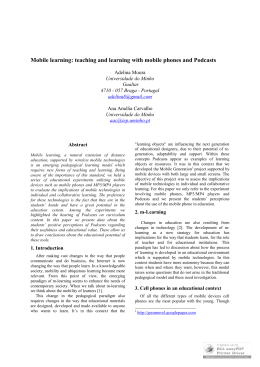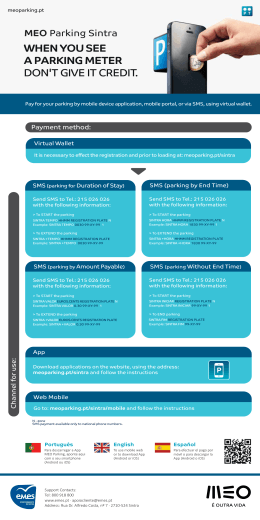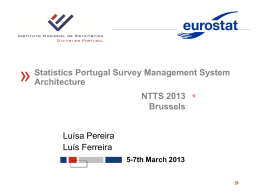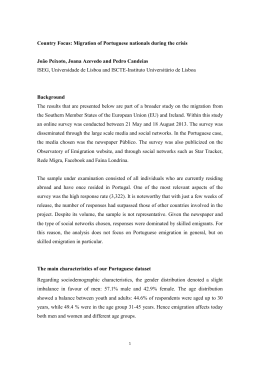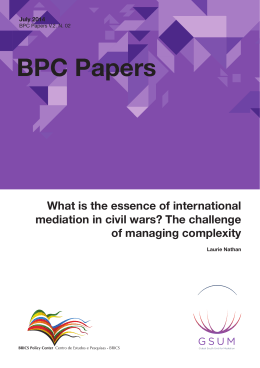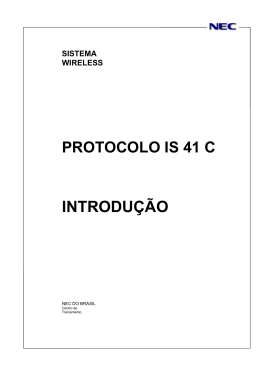Mobile phone appropriation and pedagogical mediation by students in educational contexts Adelina Moura University of Minho Braga, Portugal [email protected] Abstract The main objective of this research is to help understand students’ perceptions about using mobile phones as a learning tool. We conducted a study addressing how mobile phones are used in different learning settings, inside and outside the classroom, both in Portuguese and French classes, in a high school. A qualitative research methodology was used. The study includes four case studies that examined the use of mobile phones in the following contexts: i) as a repository of learning contents; ii) as a production tool: for writing and reading and exploring the multimedia features (audio, video and image) and iii) as an SMS-based learning scenario in Portuguese and French language (courses). The analysis of the four case studies focused on understanding tool appropriation and tool mediation. The Activity Theory principles framed the analysis in the study and were used to identify the socio-cultural aspects that influenced the process of mobile phone appropriation and determined how mobile mediated activities introduced new learning possibilities. Results showed that students’ competences (writing and reading) in French had benefited from mobile phone use and students’ engagement in learning Portuguese and French language courses was enhanced. We noted an increase in students’ motivation and satisfaction in both individual and collaborative learning. Keywords: mobile learning, appropriation, mediation, mobile phones, languages learning 1. Introduction Today, we are witnessing an increase in Internet access using mobile devices. Mobile technologies are enabling the creation of educational environments to develop Ana Amélia Carvalho University of Minho Braga, Portugal [email protected] appropriate learning activities inside and outside the classroom. Tim Berners-Lee, cocreator of the World Wide Web (WWW) predicted in 2007 that in the future the Web would seem to be everywhere because access to the Web would not only be on desktop or laptop computers, but also on mobile devices. Mobile technologies eliminate the idea of “learning happens only in the classroom” by providing access to learning materials regardless of the place and time. They allow the extension of the school boundaries and thin classroom walls. The evolution of mobile technologies underlies the emergence of mobile learning, a new educational paradigm. Both were fuelled by the human need for mobility. Although, there is a variety of projects and approaches, mostly partial, in this area, there is urgency to reconceptualise learning in the mobility era (Sharples et al., 2005), through a theoretical consolidation and the emergence of an m-learning theory giving relevance and separating it from the e-learning concept. Different definitions of m-learning have emerged during the last decade, shifting the initial focus on technology, but there are a multiplicity of meanings on the word “mobile” such as the mobility of learners, learning, content, allowing learning through different contexts and times (Kukulska-Hulme, 2009). Torrisi-Steele (2009) defines m-learning as the use of mobile devices in the curriculum, to facilitate active learning and create meaning through the creation of learning spaces, extending beyond the limitations of time and space of the traditional classroom. These learning places (m-learning spaces) are characteristically dynamic, collaborative and focused on the individual needs of learners in the current context. The teaching strategies for m-learning should involve a number of factors: mobility, context, informal, lifelong learning and tool ownership (Traxler, 2007). However in a pedagogical context adapted to this paradigm three dimensions should also be present: learner, social dimension and artifact. The Activity Theory is an appropriate theoretical framework for understanding technological innovation as part of the overall process of cultural evolution in which the artefacts mediate human activity (Bellamy, 1996). The aim of our investigation is to analyze the tool appropriation and the pedagogical mediation to better understand how a new tool can engage students in learning. In this chapter we will see how students used a personal and portable technology such as the mobile phone in different activities to learn and improve achievement. 2. The mobile phone as a learning tool Mobile technologies are familiar in the lives of most students and teachers around the world. In recent years, there have been various studies on the use of mobile phones to support activities in an educational context (Twiss, 2008, Song, 2008, Moura & Carvalho 2009). The new mobile phone multimedia features are transforming these devices into a potential tool for learning. However, the mobile phone for learning is only one adjustable part of the educational model. For the moment, this is not a standalone tool in the classroom (Prensky 2003, Sharples et al., 2009). Some authors (Waycott et al, 2005, KukulskaHulme and Traxler, 2005) consider that the use of mobile technologies such as mobile phones or PDAs have the potential to revolutionize learning. Cherian and Williams (2008) recognize that the mobile revolution is a reality and no demographic context is immune to the penetration of mobile devices. These authors even consider that m-learning is the beginning of the end of learning in the classroom. Mobile technologies, particularly mobile phones are personal and portable and can provoke a sense of personal ownership of learning tasks and technologies used to support learning in learners (Waycott et al., 2005). 2.1. Activity Theory Activity Theory (Engeström, Y. 1987, Kaptelinin et al. 1999) consists of a set of concepts that underlie a model of practice, both individual and social, as development processes. This theory has its origins in sociocultural Soviet philosophy founded by Lev Vygotsky and his colleagues Leont'ev and Luria. In this theory, an activity is formed by an individual (or group) that performs an action directed at an object (motive). The subject’s motivation is the transformation of the object into a result. Objects can be concrete (like a program, a new tool) or more abstract (an idea). Mediation tools, such as a word processor, e-mail, or a mobile phone, are artefacts used to assist in the transformation of the object into a result. Tools can be used to manipulate and understand the object (goal), or to improve the individual’s communication and motivation. Human practices are always included within a social context. In Activity Theory, the systemic relations between the person and its environment are represented by the concepts of community, rules, and the division of labour. The community is comprised by all who are interested in the activity. Social rules are the norms and social conventions established within the community. The division of labour refers to the community organization linked to the process of transforming the object into a result. Human activities are not isolated from each other. The real situations evolve in an interconnected activities network, visible in the activity system diagram (fig. 1) presented by Engeström (1987:78). Figure 1 – Engeström’s activity theory diagram 2.2. Tool appropriation mediation and tool When people begin to use technology, they can create new ways to use it not predicted by the tool creators. For example, in a mobile phone, the personal notebook can serve as a repository of contacts, but it can also be used to create a custom dictionary, as was done in this study. To Salovaara (2008) "appropriation refers to the processes that take place when new uses are invented for tools and when these uses develop into practices and start spreading within the user community". In this chapter we define tool appropriation as the integration of a new tool in learning activities. Tool mediation refers to how tools are used to achieve certain educational objectives. This notion of tool mediation contains the idea that tools are typically used in activities oriented by objectives (Waycott, 2004) and can modify activities. It means that when a new technology, such as a mobile phone, is incorporated as a tool to facilitate a particular activity, it has the power to modify it as indicated by Bellamy (1996: 124) "any artefact, technological or otherwise, has the potential to change activity”. We follow this idea of tool mediation to develop the study reported here. The concepts of tool appropriation and tool mediation both describe the two-way process by which new tools are integrated in existing activities. This means that when users integrate (appropriate) new tools into their activities, they change (mediate) those activities in various ways (Waycott, 2004). 2.3. The teaching and learning process based on SMS and Podcasts In this investigation, we proposed a set of educational activities based on Podcasts, SMS and other phone features (text, video and image) to students. Supported by the principles of Activity Theory, we have created the following models of analysis. Figure 2 shows the pattern of activity corresponding to the "Learning activity by SMS" context implemented on our investigation and based on the systemic model of Engeström (1987). The teacher designs a learning context by SMS and builds the information units which will be sent by SMS to students. In collaboration with the students, they define the timing and the number of messages sent per day. The three scenarios are the subject (reason) for learning activities by SMS that students undertake during a given period of time, supervised by the teacher at distance. Figure 2. Activities for language learning by SMS The second model corresponds to the use of the podcast for the study of curricular content. This model differs from that showed in figure 2, only in what concerns rules, where students must follow the teacher’s guidance. In the podcast model, the teacher starts by individually recording podcasts. From the podcasts made in the first activity, the teacher offers students the possibility to learn using audio files. Both teacher and students define: i) the type of technology used to listen to podcasts; ii) how they will be able to access the podcasts (Bluetooth, Wi-Fi, Web connection); iii) the most relevant episodes and, iv) podcasts’ goals. This plan served as the object (motive) for the achievement of curricular activities, and guided students. Students use the podcasts inside and outside the classroom as a supplement to the learning activities that take place in school, and to improve French pronunciation. The teacher guides students to optimize the use of podcasts as an educational resource. For each activity, the elements that structure the actions are presented through the systemic model defined by Engeström (1987) as showed in figure 3. Figure 3. Podcasts for learning Portuguese literature and improve French pronunciation Several possibilities were used to transfer podcasts files between teacher and students’ devices. Such as Bluetooth, between students and teacher mobile phone, from teacher’ netbook to students’ mobile devices (mobile phone and MP3 or MP4 players) and from the Web. The creation of SMS learning activities as well as the Podcasts was motivated by the intent of transforming these resources to support study and improve students’ learning, because both technologies are a part of students’ everyday life and are generally well accepted by them. Both contexts contain social rules, or norms, which state that students must respond correctly to the tasks by SMS and listen to podcasts following teacher guidance. In turn, the teacher presents the project, guides students, resolves conflicts, and students agree to participate in this project. In general students liked the activities proposed. Students who followed the rules participated more in the inquiry activities by SMS and listened more often the podcasts, taking satisfaction in the activities and learning improvement. 3. Study Description This research aimed to contribute to characterise learning environments supported by mobile technologies such as mobile phones as well as user acceptance and appropriation. We used a qualitative methodological approach, with multiple cases (Yin, 1984). This approach is indicated for the study of innovations developed in a school, such as the use of new educational technologies, as happened in this study, by the integration of mobile phones as a learning tool. The choice of this technology relates to the fact that: i) all participants in this study own at least one mobile phone model; ii) it is the student’s preferred mobile device; iii) the latest models have a set of multimedia features that can support learning. By opting for students own devices, we wanted to overcome any restrictions on mobile phone use as a learning tool and explore uses compatible with different equipments owned by participants of different educational levels and age ranges, and also by using only features with no related costs for students. We took advantage of the free SMS plans that students have to develop the activities by SMS. To illustrate the potential of mobile technologies to support learning, we developed several scenarios of mobile learning where mobile phones served as a mediating tool. We explored different mobile phone possibilities: a) as a content repository b) as a tool for writing, listening, and viewing c) as a production tool: text, audio, video and photo. From all activities carried out this paper focuses on the use of SMS and Podcasts. We only highlighted the results of using podcasts to learn curricula content in their native language (Portuguese) and improve pronunciation in the French and the development of a learning environment for SMS to supplement learning and collaborative work outside the classroom. Three scenarios were created to include SMS in teaching practices outside the classroom (table 1). Scenario 1 Learning units to read and store - Thoughts - Curriculum Contents - Word of the Day (iDictionary) Scenario 2 Inquire Activities Scenario 3 Collaborative Activities - Quizzes - Writing a - “Who Wants collaborative to Be micro story at Millionaire" distance - Read Daily - - Writing a (fables) collaborative - Riddles micro story - Proverbs face-to-face Table 1. SMS learning activities scenarios The learning units of Scenario 1 were sent to students for reading and storage on mobile phones for future access: thoughts for reflection, curriculum contents (grammar) for reminders, and an iDictionary creation. Scenario 2 learning units consisted in sending general knowledge quizzes, complementary curricula contents, fables for reading and responding to the moral lesson story, the game "Who Wants to Be a Millionaire" with ten multiple choice questions (one sent per day), proverbs for completation and riddles. Scenario 3 was a collaborative assignment, proposed to create micro stories from proverbs, at a distance or face-to-face by SMS. To accomplish these scenarios, we used the Vodafone service “SMS byMail” to send SMS learning units to students’ mobile phones from teacher laptops. Students answered questions by sending the teacher an SMS. Figure 4 represents the infrastructure of this experiment. Figure 4. SMS Learning activities infrastructure The podcasts files consisted of recording small episodes regarding Portuguese Literary authors. Theses episodes complemented classroom activities. The students also recorded podcasts, as well as poems lecture, dialogues, interviews and debates. To practice French pronunciation, the teacher recorded texts found in students’ textbooks, and students could practice their reading outside of the classroom. Students who trained their texts by reading showed a considerable improvement in pronunciation and lecture speed. 3.1. Data Collection Data collection was conducted using four questionnaires, individual interviews and focus groups. Questionnaire I was answered at the beginning of the study, Questionnaires II and III at the end of each learning experience (SMS and Podcasts), and Questionnaire IV, individual interviews and focus groups at the end of the study. 3.2. Participants characterization This study took place in the academic year 2008/2009 and was attended by four groups (table 2), aged 15 to 20 years in groups A, B, and C, and ages 22 to 56 in group D. This study analyzed a total of 68 participants, 46% female and 54% male. Participants from group B were from a vocational school and the other groups from a public high school. Participants from group A were composed only by male and group B only by female and both attended Portuguese classes (native classes). Groups C and D were mixed-gender and attended French classes (foreign language). Participants from group D are adult students who abandoned school and returned to continue their studies in evening classes. Groups Gender Female Male A (n=27) f % 0 0 27 100 B (n=18) f % 18 100 0 0 C (n=18) f % 10 56 8 44 D (n=5) f % 3 60 2 40 Table 2. Participants’ profile All respondents have a mobile phone, and most of them have a Nokia brand. Vodafone is the preferred provider by most participants. Some students also owned other mobile devices such as MP3, MP4 players, PSP and laptop. The services and mobile phone functionalities commonly used by participants are SMS, audio, video and camera. Most students show great dependence on their mobile phone, they never turn off the device and feel "uncomfortable" when they do not have it in their pockets. Most students report that they never used their mobile phones as a tool to support learning but they would like to do so. 3.3. Data analysis The following data were collected from four questionnaires: i) Characterization ii) podcasts as a learning resource; iii) Learning units by SMS and iv) the mobile phone as a learning tool. The data obtained from individual interviews and focus groups confirm data obtained from questionnaires and provides reliability on the information presented here. The concepts of Activity Theory were used to interpret data about how the use of new tools is shaped by cultural factors and how mobile phones seem to change the activities supported. Using Activity Theory, we can see how the possibilities and constraints introduced by the mobile phone have an effect on existing activities with learning objectives. 3.3.1. Mobile phone appropriation and mediation as a learning tool 3.3.1.1. Tool for reading and writing Although the mobile phone has been used in different learning contexts, it seems that there are similar factors that influence the use of this device as a tool for reading and writing (table 3). Dimensions Satisfaction Ease Writing support Writing type Writing features Yes No Yes No Mobile Paper Full text SMS Pad Draft SMS A (n=27) F % 23 85 4 15 27 100 0 0 16 59 11 49 16 59 11 49 10 37 10 37 7 26 B (n=18) f % 18 100 0 0 18 100 0 0 14 78 4 22 14 78 4 22 4 22 14 78 0 0 C (n=18) f % 17 94 1 6 17 94 1 6 10 56 8 44 10 56 8 44 3 17 7 39 8 44 D (n=5) f % 4 80 1 20 3 60 2 40 1 20 4 80 5 100 0 0 1 20 2 40 2 40 Table 3. Mobile phones as a reading and writing learning content tool In all groups the majority of participants is pleased to read and write curricula contents (both Portuguese and French languages) on mobile phones and found it easy to perform these actions. Most respondents from group A (59%), group B (78%), group C 56%) prefer writing on the mobile phone, however, most respondents from group D (80%) say they prefer writing on paper (these participants are adults unfamiliar with the writing and reading on mobile phones). Although the mobile phone presents itself as a new medium for reading and writing, technical limitations restrict these actions, forcing students to adapt and find new ways to use the tool for reading, such as exploring the horizontal position of screen. In the other groups, it seemed that the small size of the buttons or the screen does not hinder the reading and writing activities. This is also due to the fact that the members of these groups are familiar with texting (SMS) and reading on mobile phones and adults from group D are not. Despite the preference for mobile phones as a support for writing, there is a significant percentage of respondents who prefer writing on paper. In the interviews, one student from group B showed a clear preference for this support by stating that "only if it is the only option I have ... because I still prefer paper”. Other participants said "it is different from writing on paper"; "on paper we developed writing skills"; "I have always written on paper"; "I would not trade paper for anything, I like writing and keeping my drafts”. The preference for this traditional support can be justified by socio-cultural factors. Students are still stuck with tools that have been traditionally used to support writing: paper and pencil. Using a new tool introduces new operations on the activity. It is difficult to use new tools when users have experienced reading and writing using a paper support. If we gave students the possibility to learn supported by a new tool, we need to prepare students for a new technological environment. The adaption and adoption of any technological tool in a learning context, must consider an adjustment time in order for students to adopt the new tool. From observations, students who use mobile phones for reading and writing more often seem to get a greater satisfaction from these activities in comparison to those who do not, or have older mobile phone models with several limitations such as small screens, poor memory or basic services. Those who preferred writing on mobile phones, argued that the advantages are speed, ease and comfort. Others reported that they can use Smart Dialing to support them in full text. French students found this functionality very useful when they don’t know the correct French word, and it is also a way to learn vocabulary. A tool such as the mobile phone can create new ways of writing and reading. Due to the variety of mobile phone models owned by students, each student found the best storage and text writing strategies allowed by that specific mobile phone. The majority of respondents from group B used the draft function to write. In other groups, the choices were divided into all three applications. Block notes and draft functionalities were used by 37% of participants from group A while in group C 44% used SMS and 39% used draft and 40% of respondents from group D also used these two functionalities. A benefit of mobile phones use for writing or reading indicated by students is the possibility of combining this device with other technologies such as computers which allows the transfer of data when the memory is full, without having to write everything again. This possibility changes the accomplishment of activities, because it enables students to continue and expand texts, as well as share data with classmates. 3.3.1.2. Tool for recording and listening to podcasts The mobile phone was used by students to listen to podcasts in a Portuguese course. These podcasts contained curricula contents and texts recorded by the teacher for improvement of French language pronunciation. Students also recorded their own notes, discussions, interviews, poem recitals, individual or group recitals. The data presented below concerns the 1 pedagogical value of podcasts (table 4) . 1 Scale: A - Agreement; I - Indecision; D Disagreement Items Podcast help A learn contents I D Podcast A improve grades I D Podcasts value A lessons I D Podcasts are A lessons’ I supplement D I like podcasts A mobility I D A (n=27) f % 0 0 4 17 19 83 2 9 8 35 13 56 2 9 3 13 18 78 0 0 2 9 21 91 1 4 4 17 18 79 B (n=18) f % 0 0 0 0 17 100 0 0 9 53 8 47 0 0 4 24 13 76 1 6 2 12 14 82 0 0 3 18 14 82 C (n=18) f % 0 0 1 6 15 94 0 0 3 19 13 81 0 0 4 25 12 75 0 0 1 6 15 94 0 0 0 0 16 100 D (n=5) f % 0 0 0 0 5 100 0 0 0 0 5 100 0 0 0 0 5 100 0 0 0 0 5 100 0 0 0 0 5 100 Table 4. Pedagogical value of podcasts Most students from the four groups (with percentage of 82%), considered that podcasts helped them assimilate contents, added value to the lectures (above 74%) and acted as a class supplement (above 81%). When students were asked if podcasts improved achievement most respondents from group A, C and D agreed, but 53% of respondents from Group B showed indecision. Through these results, students recognized the pedagogical value of podcasts and mobile phone as a useful tool that supports learning. When a private tool such as mobile phone which mediates contents and students, and helps address the individual student’ needs, it is likely to be accepted as a learning tool. Portability was one of the advantages indicated in using mobile phones to listen to podcasts because access is enabled anywhere and anytime. The majority of respondents from group A (79%) and group B (82%) and all participants from group C and D were pleased to listen to podcasts wherever and whenever they wished. This feature found in mobile phones and podcasts allows students to choose the time and place of learning, as indicated by these students during the interview “in order to prepare myself for a test I listen to the podcasts when having coffee waiting for my friends"; "I listen to podcasts while travelling and sometimes I consult the dictionary too”. Students from group D, are working students so they have little time to study, thus the portability of mobile phones and podcasts helped overcome the lack of study time, allowing them to do so during free time, as reported in the interview by one student "I recorded some notes and on the way to my work I put on the earphones and pay attention to contents. Sometimes when I take a walk, or run, instead of listening to music, I listen to curricular contents, “to study". The acceptance of podcasts can be explained by the fact that participants recognized their usefulness. Curiosity was another motivational element reported by students, as in Salovaara (2009) study. 3.3.1.3. Tool to use in learning contexts by SMS We asked students about whether they liked SMS activities or not (table 5). Did you A like (n=27) activities by f % SMS? Yes 25 93 17 No 1 2 7 B (n=18) f % C (n=18) f % D (n=5) f % 94 17 94 5 100 6 1 6 0 0 Table 5. Reaction to SMS activities All participants from group D and the majority of respondents from groups A (93%), B (94%) and C (94%) enjoyed SMS activities. The same satisfaction is confirmed by data collected using individual interviews and focus groups. All students interviewed said they were pleased by from this kind of learning. In individual interviews students said they had improved their learning with SMS activities, as evidenced by these responses: "The SMS helped me learn the language ... and better assimilate the contents"; "I liked the SMS ... so much material sent... it helped me a lot”; "The SMS sent by teacher ... in my leisure time I copied them to my notebook and learned”. Scenario 3 is about collaborative work. Students had to write a micro story by SMS in a distance or face-to-face way in pairs. Writing micro stories was not performed by the group D, because they do not have enough language skills to perform this activity. In the Portuguese course students performed three experiences of writing micro stories in face-to-face and at distance learning. In the French subject it was done only once at distance learning. In the classroom, some groups chose to write the micro story on one mobile phone that passed from hand to hand, while others chose to write each one on their mobile phones and send the text by SMS to their pairs. After classes, each student wrote a paragraph of the micro story and sent it to his/her pair by SMS. On the other hand, the pair wrote another paragraph continuing the partner’ text, and so on until the story was complete. The text could not exceed 612 characters. At the end of story a student sent it by SMS to the teacher’s mobile phone for evaluation. Most students send and receive SMS in a basic daily routine, so this activity was enthusiastically received by students. Data from interviews suggest satisfaction and benefits for student learning, as in the following sentences: [written in pairs a micro story] "it is more fruitful, than alone, one gives one idea, the other gives another ... then another remembered something and together we did something else", "The micro stories ... I loved enough. [Having been collaboratively) Yes ... I used the mobile phone to send messages to my pair... when the teacher proposed that we create micro stories in a few characters I found it very interesting. I learned a lot more doing that. We needed to shorten phrases, I learned to synthesize text ". We asked students if they consider mobile phone a tool for collaboration work (table 6). Mobile A B C D phone as (n=27) (n=18) (n=18) (n=5) a tool for f % f % f % f % collaborati ve work Yes 24 89 15 83 14 78 3 60 No 3 11 3 17 4 22 2 40 Table 6 – Mobile phone for collaborative work We asked whether the participants considered mobile phones as being a useful tool for collaborative work and most of those from group A (89%), group B (83%), group C (78%) and group D (60%) responded positively. Finally, we questioned participants whether or not they considered mobile phones as being a learning tool (table 7). Mobile A B C phone is a (n=27) (n=18) (n=18) tool for f % f % f % learning Yes 23 85 17 94 18 100 5 100 No 0 4 15 1 6 0 0 D (n=5) f % 0 Table 7 – Mobile phone as a learning tool The level of agreement with the statement "The mobile phone is a tool for learning" is 85% or more in all groups which shows the recognition of the mobile phone’s new role in learning support. Crossing these data with those obtained in Questionnaire I (characterization) we found that before participating in the study, the majority of respondents (> 70%) did not recognize the usefulness and benefits of using mobile phones as a tool for supporting study. At the end of this research, we see a positive opinion regarding the potential of mobile phones as a learning tool. This positive view of the instrumental value of mobile phones as a learning support is important in considering future strategies in what concerns educational uses. Through these experiences, the participants were offered new ways to use their own mobile phone as an educational tool by exploring new uses of features that were only used for leisure or private consumption. Art students found a new use for their mobile phone, when they transformed the phone into a scanner which allowed them to convert into digital format drawings they made to illustrate the fables that were being written in French class. recording podcasts and for receiving and sending SMS for educational purposes. We also consider that, and to reflect on Carroll et al. (2003) statement, young people adopt (appropriate) the tool when it adds significant value to their lives. In this investigation, participants felt that the fact that various activities involved and were mediated by their own mobile phones benefited them in school achievement and motivated learning. 5. References 4. Conclusion In this study, students adopted the mobile phone to study because they included them in their study and learning practice and caused them to recognize them as a learning tool. The principles of Activity Theory helped describe how the use of new tools is shaped by cultural factors and that when the new tool is appropriate, it mediates the activities it supports. An interesting result is that participants who had more recent mobile phone models incorporate this device more successfully in the activities and become emotionally dependent on the artefact in comparison to those who had basic models. Being highly portable and mobile, this device seems to contribute to a feeling of emotional dependency in the younger one’s lives (Keegan, 2008). Our findings are in line with those reported by Parson et al. (2006), stating that there are positive indications that m-learning can offer the possibility of conducted quality learning strategies even in technically limited situations, as was the case of the mobile phones used in this study. We agree with the ideas of these authors when they refer that technological sophistication is not necessarily a utility measure as even the simplest technologies, such as SMS and basic mobile phones, prove stimulating rich social practices around basic systems. The most important and complex are the teaching strategies and teaching methods created with and for the technology. The use of a system as simple as sending and receiving an SMS to support learning has been one of the events experienced by study participants. This was satisfactory because it contributed to the improvement of learning and served learners’ needs, as reported by most participants. Although the phone is not used in the classroom, the results of this study show a high level of acceptance of mobile phones as a tool for reading and writing, for listening and Bellamy RKE (1996). Designing educational technology: Computer-mediated change. BA, Nardi (Ed.), Context and Consciousness: Activity Theory and Human-Computer Interaction. Cambridge, MA: The MIT Press, 123-146. Carroll J (2003). From Adoption to Use: The Process of Appropriating a Mobile Phone. Australian Journal of Information Systems (10)2, 38-38. Cherian, EJ and Williams, P (2008). Mobile Learning: The Beginning of the End of Classroom Learning. Proceedings of the World Congress on Engineering and Computer Science 2008 WCECS 2008. At http://www.iaeng.org/publication/WCECS20 08/WCECS2008_pp508-514.pdf/, 25 January 2010. Engestrom Y (1987). Learning by Expanding: An Activity-Theoretical Approach to Developmental Research. Helsinki: Orienta-Konsultit. Kaptelinin V, Nardi BA, Macaulay C (1999). The Activity Checklist: A tool for representing the "space" of context. Interactions, 1999 (July/August), 27-39. Keegan D (2008). The role of mobile learning in Europe today. Dun Laoghaire: Ericsson. Kukulska-Hulme A (2009). Will mobile learning change language learning? ReCALL, 21(2), 157–165. Kukulska-Hulme A and Traxler J (2005). Mobile Learning: A Handbook for Educators and Trainers. London: Routledge. Moura, A and Carvalho, A (2009). Mobile learning: two experiments on teaching and learning with mobile phones. R, Hijón-Neira (ed.), Advanced Learning. Vukovar, Croatia: In-Teh, 89-103 Prensky M (2004). What Can you Learn from a Cell Phone? - Almost Anything! At http://www.marcprensky.com/writing/default .asp/, 15 February 2010. Prensky M (2003). But The Screen is too Small. At http://www.marcprensky.com/writing/default. asp/ 5 February 2010. Salovaara A (2006). Studying Appropriation of Mobile Technologies. At http://www.hiit.fi/~asalovaa/articles/salovaar a-mobilehci2006-doctoral-consortium.pdf/ 11 February 2010. Salovaara A (2009). Studying appropriation of everyday technologies: a cognitive approach. Sharples M, Arnedillo-Sánchez I, Milrad M, Vavoula G (2009). Mobile Learning: Small devices, Big Issues. At http://www.lsri.nottingham.ac.uk/msh/Papers /BIG_ISSUES_REPORT_PUBLISHED.pdf/ 18 January 2010. Sharples M, Taylor J, Vavoula G (2005). Towards a Theory of Mobile Learning. Proceedings of mLearn 2005 Conference, Cape Town. At http://www.mlearn.org.za/CD/papers/Sharpl es-%20Theory%20of%20Mobile.pdf 20 January 2010. Song Y (2008). SMS enhanced vocabulary learning for mobile audiences. International Journal of Mobile Learning and Organisation, vol. 2 (1), 81-98 Torrisi-Steele G (2008). Pedagogical Perspectives on M-Learning. M. KhosrowPour (Ed.), Encyclopedia of Information Science and Technology (2ª ed.), 30413046. Hershey: Information Science Reference - Imprint of: IGI Publishing. Traxler J (2007). Defining, discussing and evaluating mobile learning: the moving finger writes and having writ …. The International Review of Research in Open and Distance Learning, vol. 8 (2). At www.irrodl.org/index.php/irrodl/article/view/3 46/875, 2 February 2010. Twiss T (2008). Ubiquitous information: An eFellow report on the use of mobile phones in classrooms to foster information literacy. At http://www.scribd.com/doc/9507014/ToniTwiss-Ubiquitous-Information/ 12 February 2010. Waycott J (2004). The appropriation of PDAs as learning and workplace tools. At http://kn.open.ac.uk/public/getfile.cfm?docu mentfileid=9608/ 28 March 2010. Waycott J, Jones A, Scanlon E (2005). PDAs as lifelong learning tools: an activity theory based analysis. Learning, Media and Technology, vol. 30( 2),107–130. Yin RK (1984). Case study research: Design and methods. Newbury Park: CA, Sage. Research integrated in CIEd.
Download
